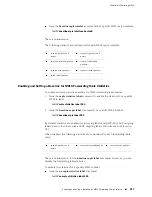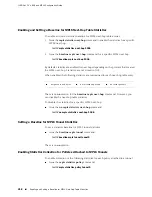
host1(config-policy-list-classifier-group)#
color green
host1(config)#
interface pos 0/0
host1(config-subif)
ip policy output core-ip-policy
5.
For traffic from the core, configure per-VR rules or per-LSP policies to set the
traffic-class/color combination—and therefore shape the egress traffic
queue—according to the value of the EXP bits in the base label. This action causes
host1(config)#
mpls match exp-bits
<value>
set traffic-class <
className
> color
Related Topics
Configuring MPLS and Differentiated Services on page 299
■
■
Configuring EXP Bits for Differentiated Services on page 300
■
Classifying Traffic for Differentiated Services on page 303
Classifying Traffic for Differentiated Services
In a differentiated services domain, traffic is classified into a behavior aggregate (BA),
based on the type of diff-serv behavior for the traffic. At each node, traffic belonging
to a particular BA is mapped to the corresponding per-hop behavior (PHB), which
provides the scheduling behavior and drop probability required by the traffic.
MPLS uses the EXP bits in the shim header to support differentiated services. The
JUNOSe software supports both statically configured and signaled mapping between
the EXP bits and the PHB of traffic.
In a signaled environment, you can configure on the ingress node the set of PHBs
that a tunnel supports, and then the set of PHBs is signaled end to end.
To support differentiated services, MPLS employs two types of LSPs: E-LSPs and
L-LSPs. The two types differ in how their PHB is determined. In the JUNOSe software,
the PHB is a combination of traffic class (also called per-hop scheduling class, or PSC)
and drop precedence (color).
■
E-LSPs (EXP-inferred-PSC LSP) can transport as many as eight BAs. For E-LSPs,
the traffic’s PHB is learned from the MPLS shim header.
■
L-LSPs (Label-only-inferred-PSC LSP) transport a single PSC. The PHB is
determined from a combination of the packet’s label, which indicates the traffic
class, and the EXP field of the shim header, which indicates the drop precedence.
■
Table 29 on page 303 indicates how the PSC (column 1) is combined with
the EXP field (column 2) to determine the PHB for incoming traffic on L-LSPs.
Table 29: Incoming L-LSP PHB Determination
PHB
=
EXP Field
+
PSC
BE
000
BE
CSn
000
CSn
Classifying Traffic for Differentiated Services
■
303
Chapter 3: Configuring MPLS
Summary of Contents for BGP
Page 6: ...vi ...
Page 8: ...viii JUNOSe 11 1 x BGP and MPLS Configuration Guide ...
Page 37: ...Part 1 Border Gateway Protocol Configuring BGP Routing on page 3 Border Gateway Protocol 1 ...
Page 38: ...2 Border Gateway Protocol JUNOSe 11 1 x BGP and MPLS Configuration Guide ...
Page 234: ...198 Monitoring BGP JUNOSe 11 1 x BGP and MPLS Configuration Guide ...
Page 236: ...200 Multiprotocol Layer Switching JUNOSe 11 1 x BGP and MPLS Configuration Guide ...
Page 542: ...506 Monitoring BGP MPLS VPNs JUNOSe 11 1 x BGP and MPLS Configuration Guide ...
Page 544: ...508 Layer 2 Services Over MPLS JUNOSe 11 1 x BGP and MPLS Configuration Guide ...
Page 610: ...574 Virtual Private LAN Service JUNOSe 11 1 x BGP and MPLS Configuration Guide ...
Page 624: ...588 VPLS References JUNOSe 11 1 x BGP and MPLS Configuration Guide ...
Page 680: ...644 Virtual Private Wire Service JUNOSe 11 1 x BGP and MPLS Configuration Guide ...
Page 724: ...688 Monitoring MPLS Forwarding Table for VPWS JUNOSe 11 1 x BGP and MPLS Configuration Guide ...
Page 725: ...Part 6 Index Index on page 691 Index 689 ...
Page 726: ...690 Index JUNOSe 11 1 x BGP and MPLS Configuration Guide ...
















































